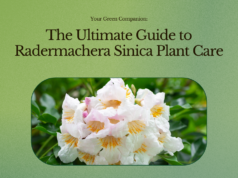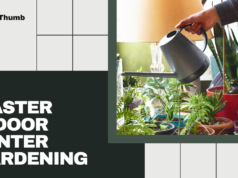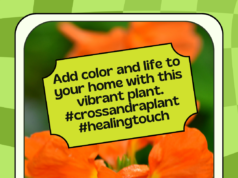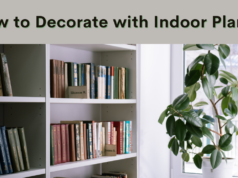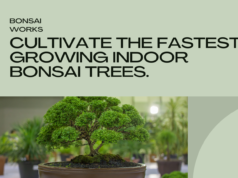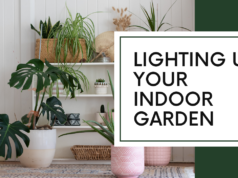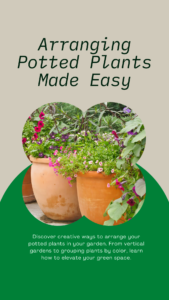
Welcome to our guide on arranging potted plants in your garden! Whether you’re a seasoned gardener or just starting out, positioning your plants effectively is the key to creating a visually stunning and thriving garden space. In this article, we will provide you with expert tips and strategies on how to assess your garden space, choose the right potted plants, arrange them for aesthetic appeal, and optimize their growth. Additionally, we’ll explore ways to maintain a functional and organized garden while enhancing the overall garden experience. Let’s dive in and transform your garden into a lush oasis!
Key Takeaways:
- Assess your garden space to make the most of your planting areas.
- Understand the sunlight requirements and microclimates in your garden for optimal plant placement.
- Choose potted plants that thrive in your garden’s conditions, considering factors such as climate and maintenance requirements.
- Arrange your potted plants strategically for aesthetic appeal, using techniques such as creating focal points and grouping plants based on texture and foliage contrast.
- Position your plants to maximize sunlight exposure and shade, promoting their optimal growth.
Assessing Your Garden Space
Before you start positioning potted plants in your garden, it’s important to assess the available space and conditions. By evaluating the size, shape, and conditions of your garden, you can make the most of your planting areas and create a well-organized and thriving garden.
Consider the following factors when assessing your garden space:
- Size: Measure the dimensions of your garden to determine how much planting space you have. This will help you plan the layout and make informed decisions about the number of plants you can accommodate.
- Shape: Analyze the shape of your garden to identify any irregularities or unique features. These can influence the placement of potted plants and contribute to the overall design aesthetic.
- Conditions: Observe the environmental conditions within your garden, such as sunlight exposure, wind patterns, and soil quality. This knowledge will enable you to select plants that thrive in your specific conditions and establish suitable microclimates.
Assessing your garden space allows you to optimize its potential and create a harmonious and visually appealing outdoor sanctuary. By taking these factors into account, you can plan your garden layout effectively and ensure optimal growth and aesthetic appeal for your potted plants.
Next, we will delve into understanding sunlight requirements and microclimates in your garden, which are crucial aspects to consider when positioning plants.
Let’s explore the impact of sunlight and microclimates in your garden and how to make the most of these factors to create a thriving garden environment.
Understanding Sunlight Requirements and Microclimates
Sunlight is a vital element for the growth and sustenance of plants in your garden. The varying sunlight requirements of different plant species must be taken into consideration when positioning them. Additionally, understanding the microclimates within your garden can help you create an ideal environment for each plant to thrive.
When it comes to sunlight requirements, some plants prefer direct sunlight throughout the day, while others thrive in partial shade. By knowing the specific needs of your plants, you can strategically position them to receive the optimal amount of sunlight.
Identifying microclimates in your garden is equally important. Microclimates are small-scale areas within your garden that have unique environmental conditions, such as variations in sunlight exposure, temperature, and moisture levels. These microclimates can occur due to factors like nearby structures, trees, or slopes.
Tip: To identify microclimates in your garden, observe the way sunlight falls and shadows are cast throughout the day. Notice areas that receive more or less sunlight, as well as spots with varying temperature or moisture levels.
- North-facing areas: These spots receive relatively less direct sunlight and tend to be cooler. They are ideal for plants that thrive in partial shade.
- South-facing areas: These areas receive the most direct sunlight and are suitable for plants that need full sun exposure.
- East-facing areas: These spots receive morning sunlight and are perfect for plants that require moderate sunlight.
- West-facing areas: These areas receive afternoon and evening sunlight, which can be intense. Plants that can withstand heat and direct sunlight are well-suited for these spots.
By strategically placing your plants in the different microclimates of your garden, you can ensure each one receives the specific sunlight intensity and duration it requires for optimal growth.
Understanding sunlight requirements and microclimates in your garden is the key to creating a thriving and visually appealing landscape. By providing the right amount of sunlight and considering the unique environmental conditions of each area in your garden, you can nurture healthy and vibrant plants.
Choosing the Right Potted Plants
When it comes to creating a thriving garden, selecting the right potted plants is crucial. By choosing plants that are well-suited to your garden’s conditions, you can ensure their long-term success and make your garden truly flourish. To help you with this important decision, we’ve gathered some key insights on how to choose the right potted plants for your garden.
Factors to Consider
When selecting potted plants, it’s important to take into account various factors that will contribute to their growth. Consider the following:
- The climate of your region: Every plant has different temperature and humidity requirements. Choose plants that are suitable for the climate in which you live to ensure their survival.
- Soil type: Some plants thrive in well-drained soil, while others prefer moist or acidic soil. Assess your garden’s soil type and choose plants that are well-suited to its characteristics.
- Maintenance requirements: Different plants have varying maintenance needs, such as watering frequency, fertilization, and pruning. Consider the time and effort you are willing to invest in caring for your plants, and choose ones that align with your gardening capabilities.
- Size, shape, and growth habits: Before selecting potted plants, think about the available space in your garden. Choose plants that will fit well and complement the existing layout. Additionally, consider their growth habits, whether they are bushy, climbing, or have a spreading growth pattern.
By carefully considering these factors, you can choose potted plants that are not only visually appealing but also compatible with your garden’s unique conditions.
Example Plants for Different Conditions
| Condition | Recommended Plants |
|---|---|
| Sunny and dry climate | Lavender, Rosemary, Succulents |
| Shaded area | Ferns, Hostas, Impatiens |
| Moist soil | Astilbe, Japanese Iris, Ligularia |
| Well-drained soil | Roses, Geraniums, Lavender |
Remember, this is just a snapshot of plant recommendations for specific conditions. Conduct further research to find plants that specifically suit your garden and its unique requirements.
Now that you have a better understanding of how to choose the right potted plants for your garden, you can start building a vibrant and thriving garden that will bring you joy for years to come.
Arranging Potted Plants for Aesthetics
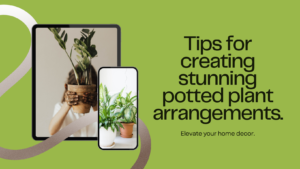
A well-arranged garden not only promotes visual appeal but also creates a harmonious and pleasing atmosphere. When it comes to arranging potted plants for aesthetics, there are several techniques you can use to create a stunning display.
Creating Focal Points
One effective technique is to create focal points within your garden by using plants with varying heights and colors. Consider placing taller plants at the back or center of a flowerbed, and surround them with shorter plants to create depth and visual interest. This arrangement draws the eye and adds visual impact to your garden.
Grouping Based on Texture and Foliage Contrast
Another technique is to group plants based on their texture and foliage contrast. Combining plants with different leaf shapes, sizes, and colors can create a captivating and eye-catching display. For example, pairing plants with finely textured leaves alongside plants with broad and lush foliage can create a striking contrast that adds visual drama to your garden.
Remember, arranging potted plants for aesthetics is all about creating a visually appealing and captivating display. By utilizing techniques such as creating focal points and grouping plants based on texture and foliage contrast, you can turn your garden into a breathtaking oasis.
Placement for Optimal Growth
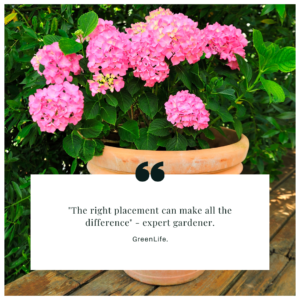
Every plant has unique growth requirements and preferences. It is important to understand the needs of each plant in order to provide the ideal conditions for their growth and development. By strategically positioning your potted plants, you can maximize sunlight exposure and shade, ensuring that each plant thrives.
When determining the placement of your potted plants, consider the sunlight requirements of each species. Some plants thrive in full sun, while others prefer partial shade. Assess the amount of sunlight each area of your garden receives throughout the day and choose plant positions accordingly. This will ensure that your plants receive the optimal amount of sunlight for their growth.
Plant Grouping
Another strategy for optimal growth is to group plants with similar water and sunlight needs together. This allows you to create microclimates within your garden that cater to the specific requirements of each plant. By understanding the preferences of your plants, you can arrange them in clusters that support their growth and promote their overall health.
| Potted Plant | Light Requirements | Watering Needs |
|---|---|---|
| Lavender | Full Sun | Low |
| Begonia | Partial Shade | Medium |
| Fern | Filtered Light | High |
For example, grouping plants that require full sun in one area and those that prefer partial shade in another area will ensure that each group receives the appropriate amount of sunlight. This targeted approach results in healthier plants and encourages optimal growth.
“By understanding the unique needs of each plant and arranging them accordingly, you can provide the best conditions for their growth and create a thriving garden.” -Gardening Expert
Additionally, consider the size and growth habits of your plants when arranging them. Be mindful of taller plants casting shadows on smaller ones, potentially depriving them of sunlight. By strategically positioning plants of varying heights, you can ensure that each plant receives ample sunlight without overshadowing others.
Ultimately, placement for optimal growth is all about considering the individual needs of your potted plants and creating an environment that supports their development. By assessing sunlight requirements, grouping plants with similar needs, and considering the size and growth habits of your plants, you can create an aesthetically pleasing garden that promotes their overall health and vitality.
Maintaining a Functional and Organized Garden
A well-maintained garden is not only beautiful but also functional. By keeping your garden organized and properly maintained, you can create a space that is both visually appealing and easy to navigate.
Provide Sufficient Space for Movement and Access
When arranging your potted plants, it’s essential to consider the space needed for movement and access within your garden. Be mindful of pathways and seating areas, ensuring there is enough room for comfortable movement and enjoyment.
Selecting Appropriate Containers
Choosing the right containers for your potted plants plays a crucial role in maintaining an organized garden. Consider the drainage needs of each plant and select containers that provide proper drainage to prevent waterlogging. Opt for containers that are not only functional but also aesthetically pleasing, complementing the overall design of your garden.
Tip: To add a touch of style to your garden, you can mix and match containers of different shapes, sizes, and materials. This will create visual interest while still maintaining a cohesive look.
Enhancing the Overall Garden Experience
Your garden is not just a collection of plants, but a space where you can find solace and tranquility. To elevate the overall garden experience, consider incorporating additional elements that add a touch of comfort and aesthetics.
Seating Areas
Creating designated seating areas in your garden allows you to fully immerse yourself in its beauty. Whether it’s a cozy bench under a shady tree or a charming patio set, having a comfortable spot to sit and relax adds a whole new dimension of enjoyment. Choose seating options that complement the style and ambiance of your garden, enhancing both functionality and visual appeal.
Pathways
Pathways not only provide structure and organization to your garden but also invite exploration. They guide visitors to different parts of your garden, allowing them to fully experience its splendor. Incorporate winding paths, adorned with beautiful stones or lush greenery, to create a sense of discovery and adventure. Well-designed pathways also ensure easy access to all areas of your garden, making maintenance tasks more convenient.
| Benefits of Enhancing the Overall Garden Experience | Table |
|---|---|
| 1. Increased relaxation and enjoyment. | 2. Added visual appeal and ambiance. |
| 3. Encourages socializing and entertaining. | 4. Improves accessibility and functionality. |
| 5. Creates a peaceful and rejuvenating environment. | 6. Enhances the value of your property. |
Balance with Other Garden Features
While potted plants are the stars of your garden, incorporating other features can create a harmonious balance. Consider adding water elements such as a small fountain or birdbath to attract wildlife and add a soothing element to your garden. Additionally, sculptures, trellises, or arbors can add architectural interest and serve as focal points. Keep in mind that these features should complement and not overpower the natural beauty of your plants.
Remember, the goal is to create a serene oasis where you can find comfort and escape from the daily hustle and bustle. By incorporating seating areas, pathways, and carefully selected garden features, you can enhance the overall garden experience and truly make it your personal sanctuary.
Adding seating areas, pathways, and complementary garden features can transform your garden into a peaceful haven where you can relax and appreciate nature’s beauty. Take the time to create a space that reflects your personality and provides a welcoming retreat for both yourself and your guests.
FAQ
Q. How do I assess my garden space for positioning potted plants?
A. To assess your garden space, take note of the available area and conditions. Consider the size, shape, and conditions of your garden, such as soil type, drainage, and microclimates. This will help you determine the suitable spots for your potted plants.
Q. What should I consider when choosing potted plants for my garden?
A. When choosing potted plants, consider your garden’s conditions, including climate, sunlight exposure, and maintenance requirements. It’s also important to take into account the size, shape, and growth habits of the plants to ensure they will thrive in your garden.
Q. How can I arrange potted plants for aesthetic appeal?
A. To create an aesthetically pleasing arrangement, you can create focal points using plants of different heights and colors. Grouping plants based on texture and foliage contrast also adds visual interest. Experiment with different combinations to find a pleasing arrangement that suits your style.
Q. How should I position my potted plants for optimal growth?
A. Each plant has specific needs, so it’s important to understand their requirements. Arrange them accordingly, making sure they receive the right amount of sunlight and shade. Strategic positioning can maximize growth by providing the ideal conditions for your plants.
Q. How do I maintain a functional and organized garden with potted plants?
A. To maintain a functional garden, ensure there is sufficient space for movement and access between your potted plants. Use appropriate containers that accommodate the plants’ needs and consider proper drainage. This will keep your garden organized and prevent any issues from arising.
Q. How can I enhance the overall garden experience with potted plants?
A. You can enhance the garden experience by incorporating additional elements such as seating areas and pathways. Balancing potted plants with other garden features creates a serene oasis where you can relax and enjoy nature’s beauty. Take the time to create a harmonious and inviting space in your garden.
Conclusion
In conclusion, proper positioning of potted plants in your garden can greatly enhance their beauty and growth. By assessing your garden space, understanding sunlight requirements, choosing the right plants, arranging them aesthetically, and considering optimal placement, you can create a lush oasis that is both functional and visually appealing.
Remember to maintain your garden and enhance the overall experience by incorporating additional elements. Whether it’s adding seating areas to enjoy the tranquility of your garden or creating pathways that invite exploration, these additional features can elevate the ambiance and offer a delightful experience.
Start implementing these strategies today and transform your garden into a stunning haven. With careful planning and attention to detail, your garden will flourish, providing you with a serene sanctuary to relax, reconnect with nature, and take pride in your green thumb.


